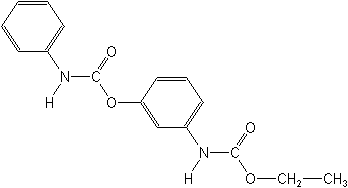-
Common NameDesmedipham
-
中文通用名甜菜安
-
IUPACethyl 3-phenylcarbamoyloxycarbanilate
-
CASethyl [3-[[(phenylamino)carbonyl]oxy]phenyl]carbamate
-
CAS No.13684-56-5
-
Molecular FormulaC16H16N2O4
-
Molecular Structure
-
Category
-
ActivityHerbicide
-
PremixEthofumesate+Desmedipham+Phenmedipham
Emulsifiable concentrate. Premix Parters: atrazine; bentazone; bromoxynil mecoprop; carfentrazone-ethyl 2,4-D mecoprop-P; carfentrazone-ethyl MCPA mecoprop-P; clopyralid 2,4-D; 2,4-D; 2,4-D dichlorprop; 2,4-D fluroxypyr; 2,4-D MCPA; 2,4-D mecoprop; 2,4-D mecoprop MSMA; 2,4-D mecoprop-P; 2,4-D mecoprop-P sulfentrazone; 2,4-D metsulfuron-methyl; 2,4-D picloram; 2,4-D quinclorac sulfentrazone; dichlorprop ioxynil; dichlorprop-P MCPA; diflufenzopyr; diflufenzopyr nicosulfuron; glyphosate; imazethapyr; ioxynil mecoprop; karbutilate; MCPA; MCPA mecoprop; MCPA triclopyr; mecoprop; mecoprop-P; primisulfuron-methyl; triasulfuron.
-
Physical PropertiesMolecular weight:300.3. Physical form:Colourless crystals. Density:Pour 0.536, tap 0.620; Composition:Tech. grade is c. 97.5% pure. Melting point:120 °C. Vapour pressure:4×10-5 mPa (25 °C); Partition coefficient(n-octanol and water):logP = 3.39 ( pH 5.9); Solubility:In water 7 mg/l ( pH 7, 20 °C). Readily soluble in polar organic solvents, e.g. acetone 400, isophorone 400, methanol 180, ethyl acetate 149, chloroform 80, dichloroethane 17.8, benzene 1.6, toluene 1.2, hexane 0.5 (all in; Stability:Stable in aqueous acidic media, but hydrolysed in neutral and alkaline media. Stable for 2 years at 70 °C; DT50 224 h in aq. solution at pH 3.8 exposed to light 280 nm.
-
ToxicologyOral:Acute oral
LD50 for rats >10 250, mice >5000 mg/kg. Percutaneous:Acute percutaneous LD50 for rabbits >4000 mg/kg. Not a skin sensitiser. Inhalation: LC50 (4 h) for rats >7.4 mg/l. Phytotoxicity:Non-phytotoxic to beet crops. ADI:( JMPR) 0.0003 mg/kg b.w. for sum of demeton-S-methyl, demeton-S-methylsulphon and oxydemeton-methyl [1989]. Be -
Environmental ProfileEcotoxicology:
Algae:IC50 (72 h) 0.061 mg/l.Bees:Not toxic to bees; LD50 >50 µg/bee.Birds: LC50 (14 d) for bobwhite quail and mallard ducks >2000 mg/kg. Dietary LC50 (8 d) for bobwhite quail and mallard ducks >5000 mg/kg diet.Daphnia: LC50 (48 h) 1.88 mg/l.Fish: LC50 (96 h) for rainbow trout 1.7, bluegill sunfish 3.2 mg/l.Worms: LC50 (14 d) 466.5 mg/kg dry soil.
Environmental fate:
Animals:In mammals, following oral administration, 80% of the parent compound and its metabolites are eliminated in the urine within 24 hours. Hydrolysis to ethyl N-(3-hydroxyphenyl)carbamate (EHPC) and conjugation (to glucuronides and ethereal sulfates)Soil:DT50 in soil c. 34 d, DT90 <115 d, with formation of ethyl 3-hydroxycarbanilate, which undergoes further degradation. Therefore, desmedipham does not accumulate in soil, nor is there any relevant uptake by foPlant:In sugar beet, EHPC is the major metabolite, with m-aminophenol as a further metabolite.
WATER SOLUBILITY: 7 mg/l at 20° C (pH 7) -
Transport InformationSignal Word:WARNING; Hazard Class:II (Moderately hazardous)
Porduct NewsMore
EU proposes not to renew approval of herbicide desmedipham
EC debates sugar beet herbicide, DMP’s future
Related CompaniesMore
Jiangsu Good Harvest-Weien Agrochemical Co., Ltd.
Country: China
Glyphosate S-metolachlor Metaldehyde Metamitron Penoxsulam Florasulam Mesotrione Amicarbazone Pyraclostrobin Mesosulfuron-methyl
Yingde Greatchem Chemicals Co., Ltd.
Country: China
Folpet Desmedipham Dazomet Captan Triticonazole Ipconazole Metconazole Boscalid Thifluzamide Ethofumesate
Country: China
Fipronil Spirodiclofen Florasulam Desmedipham Phenmedipham Ethofumesate Glufosinate-ammonium Diquat dibromide Paraquat dichloride Pyraclostrobin

 0
0 Subscribe
Subscribe
